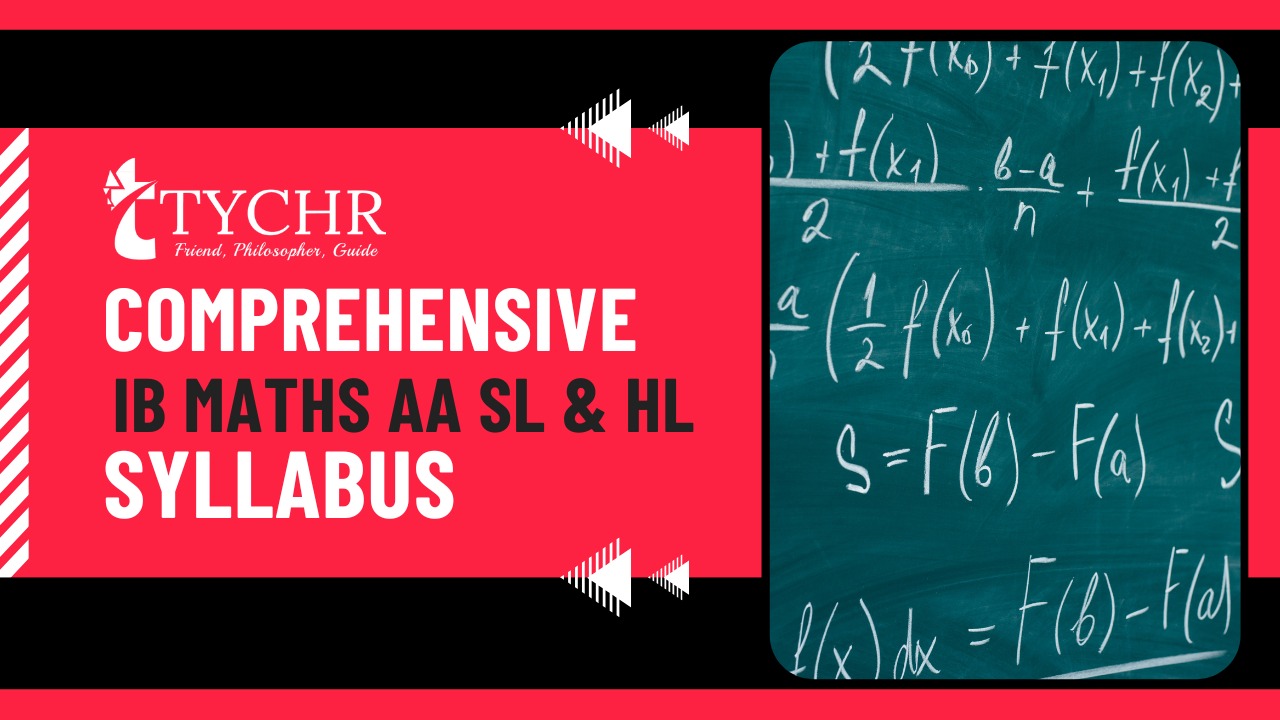Table of Contents
Curious about the Comprehensive IB Maths AA SL & HL Syllabus and what you’ll be studying?
The IB Math syllabus can seem overwhelming, but once you break it down, it’s much easier to manage. Whether you’re tackling IB Math AA SL or IB Math AA HL, knowing what’s coming up in the IB Math AA syllabus for 2025 will give you a clear path forward. The syllabus covers a wide range of topics, from calculus and algebra to statistics and probability, and understanding its structure is key to excelling in the course. In this blog, we’ll guide you through the core components of the IB Math syllabys and help you get a solid grasp of what to expect at both Standard and Higher levels. With this understanding, you’ll be able to approach your studies with confidence and make the most of your revision time.
Unit 1: Number and Algebra

| Chapter Number | IB Math Points to Understand |
| 1.1 | Conducting mathematical operations with exponential numbers and expressing them in terms of a x (bk) where a ranges from 0 < a < 10. |
| 1.2 | Sequence- A sequence is a list of numbers that is written in a defined order, ascending or descending, following a specific rule. Series- A series is the sum of all the terms in a sequence. A finite sequence has a fixed number of terms. An infinite sequence has an infinite number of terms. A term in a sequence is named using the notation 𝑎𝑛, where 𝑛 is the position of the term in the sequence. A term in a sequence is named using the notation 𝑎𝑛, where 𝑛 is the position of the term in the sequence. A sequence formed when each term after the first is found by adding a fixed non-zero number is called an arithmetic sequence. Adding up the terms of an arithmetic sequence gives us arithmetic series. |
| 1.3 | A sequence in which every term is obtained by multiplying or dividing a non-zero number with the preceding number is known as a geometric sequence. When 𝑟 > 1, the sequence is diverging. A geometric series with 𝑟 < 1 and with infinite number of terms is called an infinite geometric series. |
| 1.4 | Applications of Geometric sequences and series:
|
| 1.5 | Exponential operations and laws Logarithms and numerical evaluation of logarithms |
| 1.6 | Simple proofing techniques and deductive proof (LHS = RHS): Ex: Show that |
| 1.7 | Rational Exponents and solving its equations Laws of logarithms:
|
| 1.8 | Infinite convergent geometric sequences and its summation |
| 1.9 | A binomial is a polynomial with two terms. Pascal’s triangle is a triangular array constructed by summing adjacent |
| 1.10 (HL) | Permutation relates to the act of arranging all the members of a set into some sequence or order, or if the set is already ordered, rearranging its elements, a process called permuting The combination is a way of selecting items from a collection, such that (unlike permutations) the order of selection does not matter. Binomials with fractional and negative indices |
| 1.11 (HL) | Partial fractions: Maximum of two distinct linear terms in the denominator, with degree of numerator less than the degree of the denominator. |
| 1.12 (HL) | Complex numbers: the number i, where i2 = − 1. Cartesian form z = a + bi; the terms real part, imaginary part, conjugate, modulus and argument. |
| 1.13 (HL) | Modulus–argument (polar) form: z = r(cosθ + isinθ) = rcisθ. Euler form: z = reiθ |
| 1.14 (HL) | Complex conjugate roots of quadratic and polynomial equations with real coefficients. De Moivre’s theorem and its extension to rational exponents. Powers and roots of complex numbers. |
| 1.15 (HL) | Proof by mathematical induction Proof by contradiction Proof by counterexample to denote a statement sometimes isn’t always true |
| 1.16 (HL) | Solutions of systems of linear equations (a maximum of three equations in three unknowns), including cases where there is a unique solution, an infinite number of solutions or no solution. |
Unit 2: Functions

| Chapter number | IB Math Points to Understand |
| 2.1 | Various equations denoting a straight line:
Parallel lines (m1 = m2) Perpendicular lines ( |
| 2.2 | Functions, domains, range and graph Notation of a function – f(x), v(t) etc. The inverse of a function will only exist if the function is one-to-one. The inverse of a function 𝑓 is denoted 𝑓−1 and is a reflection about the line y = x |
| 2.3 | Formation of the equation of a graph Construction of a graph utilising information given such as the equation |
| 2.4 | Determination of key features of a graph – maximum and minimum values, root values, intercepts, horizontal and vertical asymptotes, vertices of a given graph Intersection of two curves |
| 2.5 | Composite functions Identity functions and deriving inverse function |
| 2.6 | Quadratic functions – (f(x) = ax2 + bx +c) Y-intercept, axis of symmetry and its graph(parabola) X-intercepts – f(x) = a(x-p)(x-q) where (p,0) and (q,0) are x-intercepts Vertex of a quadratic graph – f(x) = a(x – h)2 + k, where (h, k) is the coordinates of the vertex |
| 2.7 | Solution of quadratic equations and inequalities and the quadratic formula. The discriminant Δ = b2 − 4ac and the nature of the roots, that is, two distinct real roots, two equal real roots, no real roots. |
| 2.8 | Reciprocal function Rational functions – Vertical and Horizontal Asymptote equations |
| 2.9 | Exponential functions and their graphs: f(x) = ax, a > 0, f(x) = ex Logarithmic functions and their graphs: f(x)=logax, x > 0, f(x)=lnx, x > 0. |
| 2.10 | Solving equations both graphically and analytically Use of technology to solve a variety of equations, including those where there is no appropriate analytic approach. Applications of graphing skills and solving equations that relate to real-life situations. |
| 2.11 | Transformations of graphs:
Composite transformations |
| 2.12 (HL) | Polynomial functions, their graphs and equations; zeros, roots and factors. The factor and remainder theorems. Sum and product of the roots of polynomial equations. |
| 2.13 (HL) | Rational functions (Graphs, reciprocal functions) |
| 2.14 (HL) | Odd and even functions Finding the inverse function, f-1 (x), including domain restriction Self-inverse functions |
| 2.15 (HL) | Solutions of g(x) ≥ f (x), both graphically and analytically. |
| 2.16 (HL) | The graphs of the functions, y = | f (x)| and y = f(|x|), y = 1/f(x) , y = f(ax+b), y=[f(x)]2 Solution of modulus equations and inequalities |
Unit 3: Geometry and trigonometry

| Subtopic Number | IB Math Points to Understand |
| 3.1 | The distance between two points in three- dimensional space, and their midpoint. Volume and surface area of three-dimensional solids hemisphere and combinations of these solids. The size of an angle between two intersecting lines or between a line and a plane. |
| 3.2 | Use of sine, cosine and tangent ratios to find the sides and angles of right-angled triangles. Sine rule and cosine rule Area of a triangle = |
| 3.3 | Areas of triangle Equations of lines and angles between two lines Trigonometry with triangles Angle of elevation is the angle up from the horizontal and the line from the object to the person’s eye. Angle of depression is the angle down from the horizontal and the line from the object to the person’s eye. A bearing is used to indicate the direction of an object from a given point. |
| 3.4 | A radian is the measure of the angle with its vertex at the centre of the circle and two radii with their end points on the circumference Arc length: For a circle of radius 𝑟, a central angle 𝜃 subtends an arc of the circle of length 𝑠 given by 𝒔 = 𝒓𝜽, where 𝜃 is measured in radians Area of a sector |
| 3.5 | Definition of cosθ, sinθ in terms of the unit circle Definition of tanθ as sinθ/cosθ Exact values of trigonometric ratios of 0, π/6, π/4, π/3, π/2 and their multiples Ambiguous case of the sine rule |
| 3.6 | The Pythagorean identity cos2θ + sin2θ = 1 Double angle identities for sine and cosine The relationship between trigonometric ratios |
| 3.7 | The circular functions sinx, cosx, and tanx; amplitude, their periodic nature, and their graphs Composite functions of the form f (x) = asin(b(x + c)) + d Transformations Real-life Context (Height of a tide, Ferris wheel) |
| 3.8 | Solving trigonometric equations in a finite interval, both graphically and analytically Equations leading to quadratic equations in sinx, cosx or tanx |
| 3.9 (HL) | Definition of the reciprocal trigonometric ratios secθ, cosecθ and cotθ. Pythagorean identities:
The inverse functions f (x) = arcsinx, f (x) = arccosx, f (x) = arctanx; their domains and ranges; their graphs. |
| 3.10 (HL) | Compound angle identities Double angle identity for tan |
| 3.11 (HL) | Relationships between trigonometric functions and the symmetry properties of their graphs. |
| 3.12 (HL) | Concept of a vector; position vectors; displacement vectors Representation of vectors using directed line segments Base vectors i, j, k Algebraic and geometric approaches to the following:
|
| 3.13 (HL) | The definition of the scalar product of two vectors The angle between two vectors Perpendicular vectors; parallel vectors |
| 3.14 (HL) | Vector equation of a line in two and three dimensions: r = a + λb |
| 3.15 (HL) | Coincident, parallel, intersecting and skew lines, distinguishing between these cases Points of intersection |
| 3.16 (HL) | The definition of the vector product of two vectors Properties of the vector product. Geometric interpretation of | v × w | |
| 3.17 (HL) | Vector equations of a plane:
Cartesian equation of a plane ax + by + cz = d. |
| 3.18 (HL) | Intersections of: a line with a plane; two planes; three planes. Angle between: a line and a plane; two planes. |

Unit 4: Probability and Statistics

| Subtopic Number | IB Math Points to Understand |
| 4.1 | Statistics deals with data collection, organization, analysis, interpretation and presentation. Sampling is the selection of a subset of individuals from within a statistical population to estimate characteristics of the whole population. A population may refer to an entire group of people, objects, events, hospital visits, or measurements. A variable is any characteristics, number, or quantity that can be measured or counted. |
| 4.2 | Numerical or quantitative data measures a numerical quantity. Types: Discrete and Continuous Qualitative data measures a quality or characteristic of the experimental unit. A frequency distribution table is one way you can organize data so that it makes more sense. Bar charts are suitable for discrete data, while a histogram is used for continuous data. Cumulative frequency graph is a line graph. |
| 4.3 | A measure of central tendency is a summary statistic that represents the center point or typical value of a dataset. The mean is the arithmetic average. The mode is the value that occurs most frequently in a set of data. The median is the middle data value when the data values are arranged in order of size. Measure of dispersion of data Quartiles of discrete data |
| 4.4 | Linear correlation of bivariate data Pearson’s product-moment correlation and its coefficient r – only applicable in linear relationships Scatter diagrams Equation of regression line of y on x, using it in prediction and interpretation of its parameters, a and b, in the linear regression y = ax + b. |
| 4.5 | Experiment: A process by which you obtain an observation. Trials: Repeating an experiment a number of times. Outcome: A possible result of an experiment. Event: An outcome or set of outcomes. Sample space: The set of all possible outcomes of an experiment, always denoted by U. |
| 4.6 | Venn, tree and sample space diagrams Conditional probability |
| 4.7 | Discrete Random Variables, its probability distributions, expected value and its applications |
| 4.8 | Binomial Distribution and calculation of its mean and variance |
| 4.9 | Dependent Events are where what happens depends on what happened before, such as taking cards from a deck makes less cards each time Two events A and B are independent if the occurrence of one does not affect the chance that the other occurs. 𝑃(𝐴|𝐵) is known as conditional probability. |
| 4.10 | Equation of the regression line of x on y Predictions using equations |
| 4.11 | Formal definition and use of the formulae: P(A|B) = P(A ∩ B) / P(B) for conditional probabilities, and P(A|B) = P(A) = P(A|B′) for independent events |
| 4.12 | Standardisation of normal variables (z– values) Inverse normal calculations where mean and standard deviation are unknown. |
| 4.13 (HL) | Use of Bayes’ theorem for a maximum of three events. |
| 4.14 (HL) | Variance of a discrete random variable Continuous random variables and their probability density functions Mode and median of continuous random variables Mean, variance and standard deviation of both discrete and continuous random variables |
Unit 5: Calculus

| Subtopic Number | IB Math Points to Understand |
| 5.1 | Differential calculus deals with the study of the rates at which quantities change. Limit– A value we get closer and closer to, but never quite reach. One-sided limits are those limits that only converge to a single value on one side of a function. |
| 5.2 | The derivative of a function may be used to determine whether the function is increasing or decreasing on any intervals in its domain. |
| 5.3 | Derivative of f (x) = axn is f ′(x) = anxn − 1, n ∈ Z The derivative of functions of the form f (x) = axn + bxn − 1 . . . . where all exponents are integers. |
| 5.4 | A tangent to a curve is a line that touches the curve at one point and has the same slope as the curve at that point. A normal to a curve is a line perpendicular to a tangent to the curve. Finding equation of tangent and normal |
| 5.5 | Introduction to integration as anti-differentiation of functions of the form f(x) = axn + bxn − 1 + …., Definite integrals using technology Area of a region enclosed by a curve y = f (x) and the x -axis, where f (x) > 0. |
| 5.6 | Derivative of xn (n ∈ Q), sinx, cosx, ex and lnx. Differentiation of a sum and a multiple of these functions Chain rule for composite function Product and Quotient rule (for differentiation) |
| 5.7 | Given a function 𝑓(𝑥), the derivative 𝑓′(𝑥) is known as the first derivative of 𝑓(𝑥). The gradient of the first derivative, 𝑓′′(𝑥) is called the second derivative of 𝑓(𝑥). Graphical behaviour of functions, including the relationship between the graphs of f , f ′ and f ′′ |
| 5.8 | Critical points are the points where 𝑓′ is zero or undefined. This method of checking if the function is increasing or decreasing and about which point is called the first derivative test. A maximum or minimum is said to be local if it is the largest or smallest value of the function, respectively, within a given range. Point of inflection: These are critical points of a function. These are the points where 𝑓′(𝑥) or the slope of the curve is zero. |
| 5.9 | Kinematic problems involving displacement s, velocity v, acceleration a and total distance travelled. |
| 5.10 | Integration by inspection (reverse chain rule) or by substitution for expressions of the form The composites of any of these with the linear function ax+b Indefinite integral of xn (n ∈ Q), sin x, cos x, 1/x and ex |
| 5.11 | Definite integrals, including analytical approach Areas of a region enclosed by a curve y = f (x) and the x-axis, where f (x) can be positive or negative, without the use of technology Areas between curves |
| 5.12 (HL) | Informal understanding of continuity and differentiability of a function at a point Understanding the limits (convergence and divergence) Definition of derivatives from first principles Higher derivatives |
| 5.13 (HL) | Evaluation of limits using l’Hôpital’s rule or the Maclaurin series Repeated use of l’Hôpital’s rule |
| 5.14 (HL) | Implicit differentiation Related rates of change Optimisation problems. |
| 5.15 (HL) | Derivatives of tanx, secx, cosecx, logax, arcsinx, arccosx, arctanx. Indefinite integrals of the derivatives of any of the above functions The composites of any of these with a linear function Use of partial fractions to rearrange the integrand |
| 5.16 (HL) | Integration by Substitution is a method to find an integral, but only when it can be set up in a special way Integration by parts Repeated integration by parts |
| 5.17 (HL) | Area of the region enclosed by a curve and the y-axis in a given interval Volumes of revolution about the x-axis or the y-axis |
| 5.18 (HL) | First order differential equations Numerical solution of dy = f (x, y) dx using Euler’s method Solution of y′ + P(x)y = Q(x), using the integrating factor |
| 5.19 (HL) | Maclaurin series to obtain expansions for ex, sinx, cosx, ln(1 + x), (1 + x)p, p ∈ Q Use of simple substitution, products, integration and differentiation to obtain other series Maclaurin series developed from differential equations |
When it comes to acing your IB Maths journey, there’s no better support than Tychr. Our team of 1-on-1 hyper personalized, Cat (1,2 & 3) certified IB tutors is here to help you understand the material deeply and ensure you’re fully prepared for your exams. Whether you’re studying for IB Math AA SL or IB Math AA HL, Tychr provides the tailored guidance you need to succeed. With expert tutors by your side, you can master the syllabus and approach your IB Math assessments with confidence.








